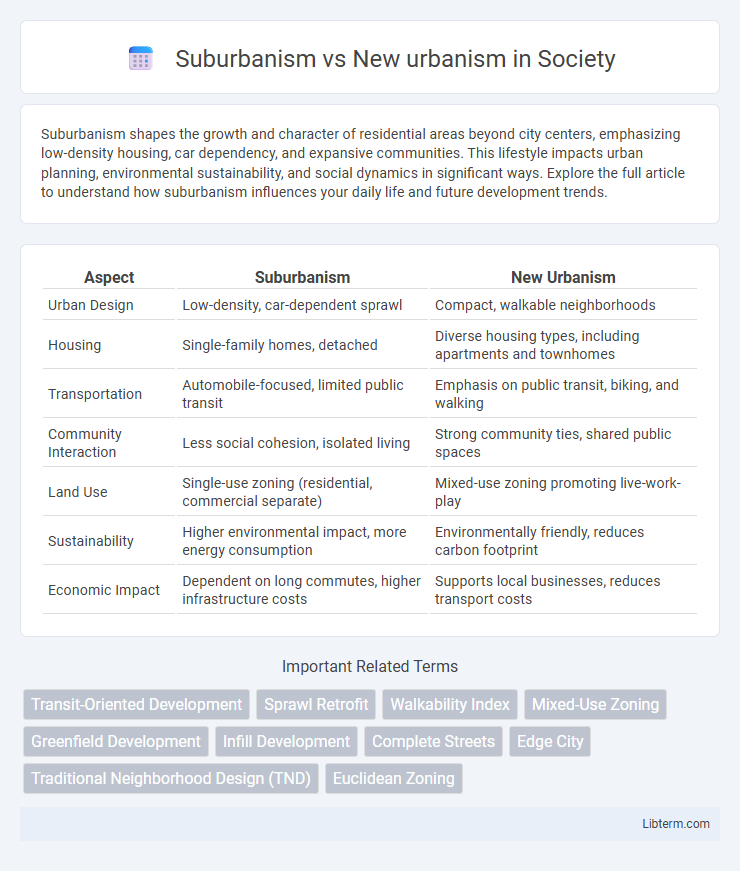Suburbanism shapes the growth and character of residential areas beyond city centers, emphasizing low-density housing, car dependency, and expansive communities. This lifestyle impacts urban planning, environmental sustainability, and social dynamics in significant ways. Explore the full article to understand how suburbanism influences your daily life and future development trends.
Table of Comparison
| Aspect | Suburbanism | New Urbanism |
|---|---|---|
| Urban Design | Low-density, car-dependent sprawl | Compact, walkable neighborhoods |
| Housing | Single-family homes, detached | Diverse housing types, including apartments and townhomes |
| Transportation | Automobile-focused, limited public transit | Emphasis on public transit, biking, and walking |
| Community Interaction | Less social cohesion, isolated living | Strong community ties, shared public spaces |
| Land Use | Single-use zoning (residential, commercial separate) | Mixed-use zoning promoting live-work-play |
| Sustainability | Higher environmental impact, more energy consumption | Environmentally friendly, reduces carbon footprint |
| Economic Impact | Dependent on long commutes, higher infrastructure costs | Supports local businesses, reduces transport costs |
Understanding Suburbanism: Key Characteristics
Suburbanism is characterized by low-density residential developments, predominately single-family homes, and a strong dependence on automobile transportation due to limited public transit options. It typically features zoning that separates residential, commercial, and industrial areas, contributing to spatial segregation and reduced walkability. These suburban environments often prioritize private yards and open spaces but face challenges related to urban sprawl, environmental impact, and infrastructure costs.
Defining New Urbanism: Principles and Goals
New Urbanism emphasizes walkable neighborhoods, mixed-use developments, and sustainable urban growth, aiming to counter the sprawl and car dependency typical of suburbanism. Its principles include promoting diverse housing types, creating public spaces that encourage social interaction, and integrating transit options to reduce environmental impact. The goal is to foster vibrant, livable communities that balance environmental, economic, and social needs.
Historical Context: How Suburbs and New Urbanism Emerged
Suburbanism emerged in the early 20th century, driven by industrialization, mass automobile ownership, and a desire for residential separation from urban centers, leading to expansive, car-dependent communities. New Urbanism arose in the late 20th century as a response to suburban sprawl, emphasizing walkable neighborhoods, mixed-use development, and sustainable urban planning principles to counteract environmental and social issues caused by traditional suburbs. Both movements reflect shifting priorities in urban design shaped by technological advances and cultural attitudes toward community and mobility.
Urban Planning Philosophies: Contrasts and Comparisons
Suburbanism emphasizes low-density, automobile-dependent development with separated land uses, prioritizing private space and convenience for car travel. New Urbanism advocates for walkable neighborhoods, mixed-use development, and public transit access to create vibrant, community-focused environments. These contrasting urban planning philosophies reflect divergent goals in sustainability, social interaction, and urban design efficiency.
Transportation and Mobility: Cars vs Walkability
Suburbanism emphasizes car dependency with sprawling layouts designed for automobile travel, often resulting in longer commutes and limited public transit options. New Urbanism prioritizes walkability and mixed-use development, promoting pedestrian-friendly streets, bike infrastructure, and accessible public transportation. This approach reduces reliance on cars, encourages sustainable mobility, and fosters community interaction through connected, compact urban environments.
Social Connectivity and Community Life
Suburbanism often results in fragmented social connectivity due to car-dependent layouts and separated land uses, limiting spontaneous interactions and weakening community life. New urbanism emphasizes walkability, mixed-use developments, and public spaces that foster frequent face-to-face interactions and stronger neighborhood bonds. Empirical studies show communities designed around new urbanist principles report higher social capital and resident satisfaction compared to traditional suburban environments.
Environmental Impacts: Sustainability Concerns
Suburbanism often leads to increased car dependency, higher greenhouse gas emissions, and significant land consumption, contributing to habitat fragmentation and loss of biodiversity. New Urbanism promotes walkable neighborhoods, mixed-use development, and public transit access, reducing carbon footprints and preserving green spaces. Emphasizing compact design and energy-efficient buildings, New Urbanism supports sustainability goals by mitigating urban sprawl and lowering environmental degradation.
Housing Diversity and Affordability
Suburbanism typically features homogeneous housing types, predominantly single-family homes, which limits housing diversity and often drives up costs due to land consumption and infrastructure expenses. New Urbanism emphasizes a mix of housing types such as townhouses, apartments, and accessory dwelling units, promoting increased density and affordability by making efficient use of land and encouraging walkable neighborhoods. This diversity in housing options under New Urbanism fosters inclusivity and addresses varied income levels more effectively than traditional suburban developments.
Urban Design: Layout, Density, and Public Spaces
Suburbanism typically features low-density residential areas with segregated land uses, characterized by cul-de-sacs and car-dependent layouts that limit walkability and reduce communal public spaces. New Urbanism emphasizes higher density, mixed-use developments with interconnected street grids designed to promote walkability, social interaction, and diverse public spaces that encourage community engagement. Urban design under New Urbanism integrates green spaces, pedestrian pathways, and transit-oriented development to create sustainable, vibrant neighborhoods contrasting with the sprawling, auto-centric patterns of suburbanism.
The Future of Urban Development: Trends and Predictions
Suburbanism emphasizes low-density, car-dependent communities that prioritize single-family homes and expansive green spaces, often leading to urban sprawl and increased infrastructure costs. New Urbanism promotes walkable, mixed-use neighborhoods with diverse housing options and integrated public transit, aiming to reduce environmental impact and foster community engagement. Future urban development is likely to prioritize sustainable designs inspired by New Urbanism principles, incorporating smart technologies and resilience strategies to address climate change and evolving demographic needs.
Suburbanism Infographic

 libterm.com
libterm.com